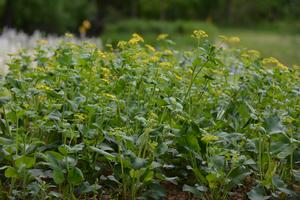New Moon Nurseries
Zizia aptera
Heartleaf Alexander's
Native to North America
FIRST IMPRESSIONS: Zizia aptera is a 1-3’ tall upright perennial wildflower with glossy heart shaped basal leaves. From late spring to early summer flowering stems elongate bearing showy flat topped clusters of small yellow florets. Scads of beneficial pollinators flock to the blooms. This golden beauty thrives in sunny sites with average or moist calcareous soil.
HABITAT & HARDINESS: Zizia aptera occurs in most of the southern Canadian provinces and from Connecticut to Washington state and south to the Florida panhandle, Mississippi and Utah. According to USDA range maps the species is absent from most of the New England states and from California, Arizona, New Mexico, Texas, Louisiana, Nebraska and Kansas.
Plants are indigenous to moist or mesic Blackland prairies, hill prairies, limestone glades, bluffs, rocky upland woods, thickets, fields and roadsides from USDA Zones 3-8.
PLANT DESCRIPTION: Zizia aptera is a mostly unbranched erect tap-rooted perennial.
Plants have simple heart shaped basal foliage. Basal blades are about 4” long with bluntly rounded tips, toothed margins and long petioles.
Several smooth hairless stems with light green vertical lines rise from the basal rosettes.
The stems bear alternate leaves that are usually compound. They are topped by compound umbels of tiny yellow florets.
Each umbel averages 2-3” across and contains 70-300 florets that are about 1/8” wide.
Blooming begins in late spring and continues for about a month. The florets mature into small oblong ribbed seed.
Plants grow 1-3’ tall with a 1-2’ spread.
CULTURAL & MAINTENANCE NEEDS: Zizia aptera flourishes in sun or part sun with moist or dry soil. Plants tolerate clay loam, rocky or gravelly soil, alkaline pH and controlled burns.
This species is easy to grow but is considered to be a short lived perennial that persists by re-seeding.
LANDSCAPE USES: This is a good choice for a Wildlife Garden or sunny Meadow. Plants are also used as Butterfly Nectar Plants, Butterfly Host Plants or as part of a Grouping or Mass Planting. Zizia aptera has Showy Blooms and is appropriate for Cottage Gardens, Cut Flower Gardens, Low Maintenance Plantings, Prairie Gardens and Perennial Borders.
COMPANION & UNDERSTUDY PLANTS: Try pairing Zizia aptera with Amsonia tabernaemontana, Anemone virginica, Bouteloua curtipendula, Carex bicknellii, Echinacea pallida, Schizachyrium scoparium or Sporobolus heterolepis.
Zizia aurea has similar appearance and culture and could be substituted in some garden situations.
TRIVIA: Zizia aptera belongs to the Apiaceae or Umbelliferae (Carrot Family). The generic name is in honor of German botanist Johann Baptist Ziz (1779–1829). The specific epithet aptera means “without wings” because this species has wingless seed.
Zizia spp. are commonly called Alexanders in reference to a medicinal herb species (Smyrnium olusatrum) used by the ancient Romans. These herbs were also in the Carrot Family and were called Alexanders because they were first found near the city of Alexandria.
Many species of small short tongued bees, pollinating flies, butterflies, beetles and plant bugs seek nectar and pollen from the flowers. Black swallowtail butterfly caterpillars feed on the foliage.
Zizia aptera differs from the closely related Z. aurea because it has simple basal leaves and a preference for drier sites. Z. aurea has compound basal leaves and a preference for wetter sites.
Height:
1-3 FeetSpread:
1-2 ftSpacing:
18-24 inUSDA Hardiness Zone:
3-8Bloom Color:
YellowZizia aptera Characteristics
Attracts Wildlife
- Butterflies
- Pollinators
Attributes
- Rock Garden
- Interesting Foliage
- Drought Tolerant
- Cut Flower
- Clay Soil
Exposure
- Full Sun to Partial Shade
Flowering Months
- July
- June
- May
Foliage Color
- Green
Season of Interest (Foliage)
- Spring
- Summer
Soil Moisture Preference
- Moist to Dry
